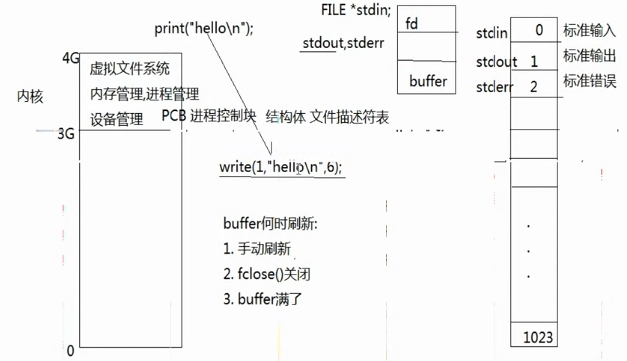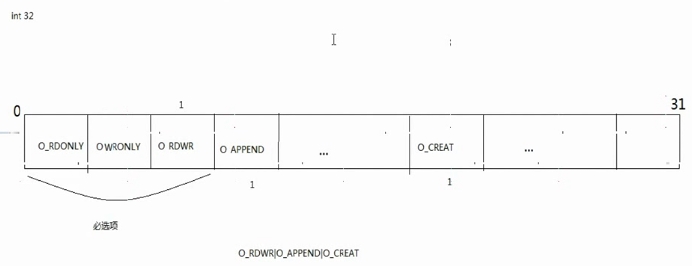在学习Linux命令基础总结了笔记,并分享出来。有问题请及时联系博主:Alliswell_WP,转载请注明出处。
08-linux-day03(makefile-gdb-IO)
目录:
附:ftp工具介绍——FlashFXP
一、学习目标
二、makefile
1、makefile编写1
2、makefile编写2
3、makefile编写3
4、makefile补充
三、gdb
1、gdb调试
2、gdb调试core文件
四、系统函数
1、系统api与库函数的关系
2、open、close函数介绍
3、open、close实现
4、read、write
5、lseek实现文件读写位置改变
6、lseek计算文件大小
7、lseek拓展文件
8、阻塞和非阻塞相关的概念
9、fcntl函数设置非阻塞
附:ftp工具介绍——FlashFXP
FlashFXP允许你从任何FTP服务器直接传输文件到你的本地硬盘,或者在两个FTP站点之间传输文件,即站点到站点传输,而无须经过自己的计算机。要实现站点至站点的文件传递,我们需要将本地文件浏览器界面切换至远程文件浏览器界面,并且需要两个站点都支持此功能。
FlashFXP下载(免安装):https://www.cr173.com/soft/15632.html
FlashFXP与虚拟机VMware进行文件传输——http://www.linuxidc.com/Linux/2010-07/26992.htm
ubuntu安装ftp服务器(一般配置)+FlashFXP与虚拟机传输文件——https://www.cnblogs.com/wolf-sky/archive/2012/09/19/2694311.html
使用:打开“站点”——>“站点管理器”——>“新建站点”,名字随便起(如:new),确定——>连接类型:选择“SFTP over SSH”;地址输入:“192.168.5.100”(Ubuntu的IP地址),用户名输入:wang,密码输入:root;远程路径输入:/home/wang(也可以不配置)——>点击“应用”;点击“连接”。
连接成功后,左侧为“Windows系统的文件”,右侧为“Ubuntu的文件”,将左右侧分别选择到文件位置和待拷贝的位置,然后鼠标选中“准备拷贝的文件”,然后鼠标右键“传输选定项”,就会传到“待拷贝位置”。
一、学习目标
1、熟练使用规则编写简单的makefile文件
2、熟练使用makefile中的变量
3、熟练使用makefie中的函数
4、熟练掌握gdb相关调试命令的使用
5、了解概念:pcb和文件描述符,虚拟地址空间
6、熟练掌握Linux系统IO函数的使用(open、read、write、lseek)
7、了解阻塞和非阻塞的概念
二、makefile
文件准备:head.h main.c add.c sub.c div.c mul.c
新建目录include,将head.h放入其中,head.h:
1 int add(int a, int b); 2 int sub(int a, int b); 3 int div(int a, int b); 4 int mul(int a, int b);
main.c:
1 #include <stdio.h> 2 #include "head.h" 3 int main(int a, int b) 4 { 5 int sum = add(2, 24); 6 printf("sum = %d ", sum); 7 return 0; 8 }
add.c:
1 #include "head.h" 2 int add(int a, int b) 3 { 4 int result = a + b; 5 return result; 6 }
sub.c:
1 #include "head.h" 2 int sub(int a, int b) 3 { 4 int result = a - b; 5 return result; 6 }
div.c:
1 #include "head.h" 2 int div(int a, int b) 3 { 4 int result = a / b; 5 return result; 6 }
mul.c:
1 #include "head.h" 2 int mul(int a, int b) 3 { 4 int result = a * b; 5 return result; 6 }
1、makefile编写1
(1)makefile的命名规则:
makefile
Makefile
(2) makefile的三要素
目标
依赖
规则命令
(3)写法
目标:依赖
Tab键 规则命令
如:(第1版makefile)
app:main.c add.c sub.c div.c mul.c
gcc -o app -I./include main.c add.c sub.c div.c mul.c
如果更改其中一个文件,所有的源码都重新编译
可以考虑编译过程分解,先生成.o文件,然后使用.o文件生成结果(规则是递推的,依赖文件如果比目标文件新,则重新生成目标)
如:(第二版makefile)
app:main.o add.o sub.o div.o mul.o
gcc -o app -I./include main.o add.o sub.o div.o mul.o
main.o:main.c
gcc -c main.c -I ./include
add.o:add.c
gcc -c add.c -I ./include
sub.o:sub.c
gcc -c sub.c -I ./include
div.o:div.c
gcc -c div.c -I ./include
mul.o:mul.c
gcc -c mul.c -I ./include
更改:
#ObjFiles定义目标文件
ObjFiles=main.o add.o sub.o div.o mul.o
#目标文件用法:$(var)
app:$(ObjFiles)
gcc -o app -I./include main.o add.o sub.o div.o mul.o
main.o:main.c
gcc -c main.c -I ./include
add.o:add.c
gcc -c add.c -I ./include
sub.o:sub.c
gcc -c sub.c -I ./include
div.o:div.c
gcc -c div.c -I ./include
mul.o:mul.c
gcc -c mul.c -I ./include
2、makefile编写2
makefile的隐含规则:默认处理第一个目标
》函数:
wildcard可以进行文件匹配
patsubst内容的替换
》变量:
$@——代表目标
$^——代表全部依赖
$<——第一个依赖
$?——第一个变化的依赖
继续更改:(第三版makefile)
#get all .c files
SrcFiles=$(wildcard *.c)
#all .c files --> .o files
ObjFiles=$(patsubst %.c,%.o,$(SrcFiles))
#目标文件用法:$(var)
app:$(ObjFiles)
gcc -o app -I./include $(ObjFiles)
#模式匹配规则,$@,$<,这样的变量,只能在规则中出现
%.o:%.c
gcc -c $< -I./include -o $@
#测试变量
test:
echo $(SrcFiles)
echo $(ObjFiles)
》测试变量:make test
3、makefile编写3
》增加清理功能,
继续更改:(第四版makefile)
#get all .c files
SrcFiles=$(wildcard *.c)
#all .c files --> .o files
ObjFiles=$(patsubst %.c,%.o,$(SrcFiles))
#目标文件用法:$(var)
app:$(ObjFiles)
gcc -o app -I./include $(ObjFiles)
#模式匹配规则,$@,$<,这样的变量,只能在规则中出现
%.o:%.c
gcc -c $< -I./include -o $@
#测试变量:@命令不输出
test:
@echo $(SrcFiles)
@echo $(ObjFiles)
#清理功能:-f强制删除;规则前的@命令代表不输出该条规则的命令;规则前的-代表该条规则执行报错,继续执行;
clean:
-@rm *.o
rm -f app
》清理文件:make clean
》在本目录下增加clean文件,clean不能使用
继续更改:(第五版makefile)
#get all .c files
SrcFiles=$(wildcard *.c)
#all .c files --> .o files
ObjFiles=$(patsubst %.c,%.o,$(SrcFiles))
all:app app1
(空行)
#目标文件用法:$(var)
app:$(ObjFiles)
gcc -o $@ -I./include $(ObjFiles)
app1:$(ObjFiles)
gcc -o $@ -I./include $(ObjFiles)
#模式匹配规则,$@,$<,这样的变量,只能在规则中出现
%.o:%.c
gcc -c $< -I./include -o $@
#测试变量:@命令不输出
test:
@echo $(SrcFiles)
@echo $(ObjFiles)
#清理功能:-f强制删除;规则前的@命令代表不输出该条规则的命令;规则前的-代表该条规则执行报错,继续执行;
#定义伪目标,防止有歧义
.PHONY:clean all
clean:
-@rm -f *.o
-@rm -f app app1
》清理文件:make clean
4、makefile补充
(1)头文件更改,.o需要重新编译,所以不推荐把头文件放到app:$(ObjFiles) include/head.h
(2)指定编译某个文件:make -f makefile1
三、gdb
文件准备:head.h fun.c main.c(在目录gdb0629下)
main.c:
1 #include <stdio.h> 2 #include <string.h> 3 #include <stdlib.h> 4 #include "head.h" 5 typedef struct TTfunInfo 6 { 7 int fun_type;//函数的类型 8 int a;//函数的第一个参数 9 int b;//函数的第二个参数 10 char funname[10];//函数名称 11 }TfunInfo; 12 int main(int argc, char* argv[]) 13 { 14 int a = 2; 15 int i = 0; 16 int a1 = 10, b1 =5; 17 TfunInfo funinfo[2]; 18 char *Msg = "I will die!"; 19 //Msg[0] = '1'; 20 if(argc == 3) 21 { 22 a1 = atoi(argv[1]); 23 b1 = atoi(argv[2]); 24 funinfo[0].a = a1; 25 funinfo[0].b = b1; 26 funinfo[1].a = a1; 27 funinfo[1].b = b1; 28 } 29 for(i = 0; i < 2; i++) 30 { 31 printf("i===%d,LINE=%d ",i,__LINE__); 32 if(i == 0) 33 { 34 funinfo[i].fun_type = 1;//call sum 35 printf("begin call sum "); 36 strcpy(funinfo[i].funname, "sum"); 37 sum(funinfo[i].a, funinfo[i].b); 38 } 39 if(i == 1) 40 { 41 funinfo[i].fun_type = 2;//call mul 42 printf("begin call mul "); 43 strcpy(funinfo[i].funname, "mul"); 44 mul(funinfo[i].a, funinfo[i].b); 45 } 46 } 47 printf("byebye "); 48 return 0; 49 }
head.h:
1 int sum(int a, int b); 2 int mul(int a, int b);
func.c:
1 #include <stdio.h> 2 #include "head.h" 3 4 int sum(int a, int b) 5 { 6 printf("weldome call %s,a=%d,b=%d ",__FUNCTION__,a,b); 7 return a+b; 8 } 9 int mul(int a, int b) 10 { 11 printf("weldome call %s,a=%d,b=%d ",__FUNCTION__,a,b); 12 return a*b; 13 }
1、gdb调试
使用gdb:编译的时候加-g参数
如:gcc func.c main.c -o app -I./ -g
启动gdb:gdb app(对应可执行程序名)
按回车可以继续执行下一条指令
r(un)——启动
run也可以指定参数,如:r 12 7(相当于./app 12 7)
start——启动,停留在main函数,分步调试
n(ext)——下一条指令,
s(tep)——下一条指令,可以进入函数内部,库函数不能进
q(uit)——退出gdb
set——给参数或变量赋值
设置启动参数:set args 10 6(相当于./app 10 6)
set 变量名=值(如:set args=3——当函数执行至断点前,临时把判断条件的值改变)
(如:set argv[1]="12";(回车)set argv[2]="7"——临时把argv[1]和argv[2]赋值)
l(ist)——默认查看还有main函数的代码,默认10行,回车,继续10行
l 文件名:行号(如:l func.c:1——查看func.c从第1行开始的10行代码)
b(reak)——增加断点
b 行号(如:b 17——默认在main函数第17行设置了断点)
b 函数名(如:b sum——在func.c的sum函数处设置了断点)
b 文件名:行号(如:b func.c:6——func.c第6行设置了断点)
设置条件断点
b 行号 条件(如:b 32 if i==1——只有if=1的时候才进入断点,即停止)
i(nfo) b——查看所有断点编号
d(elete)——删除断点
d 断点标号(如:d 4——删除info表中的4号断点)
c(ontinue)——继续执行,直到下一个断点
p(rint)——打印变量的值
p 变量名(如:p argc——打印变量argc的值:$1 = 3)
p 结构体名(如:p funinfo——打印结构体funinfo中各个值的信息:$2 = {{fun_type = 1, a = 10, b = 419666005, funname = }...})
p 变量名(如:p i——打印i的值:$3 = 0)
ptype——打印 变量的类型
ptype 变量(如:ptype i——打印i的类型:type = int)
display——追踪某个变量的值,查看变量具体什么时候变化,每步执行,都打印
display 变量名(如:display argc——跟踪输出argc的值:argc = 1)
info display——查看所有跟踪的变量名及编号
undisplay——删除显示变量,需要查看编号
undisplay 编号(如:undisplay 1——删除跟踪编号为1的变量)
2、gdb调试core文件
设置生成core:ulimit -c unlimited
取消生成core:ulimit -c 0
设置core文件格式:/proc/sys/kernel/core_pattern
文件不能vi,可以用后面的套路 echo "/corefile/core-%e-%p-%t">/proc/sys/kernel/core_pattern
%e:添加命令名;%p添加pid;%t添加core文件生成时的unix时间
core记录了案发现场
gdb app core——将会显示在哪里出错了,如果还是看不到,输入where查看
四、系统函数
1、系统api与库函数的关系


2、open、close函数介绍
》open
查看man 2 open
int open(const char* pathname, int flags);
int open(const char* pathname, int flags, mode_t mode);
pathname 文件名
flags
必选项:
O_RDONLY只读;
O_WRONLY只写;
O_RDWR读写
可选项:
O_APPEND追加;
O_CREAT创建文件
O_EXCL与O_CREAT一起使用,如果文件存在,则报错
mode权限位,最终(mode &~ umask)
ONONBLOCK非阻塞
返回值:返回最小的可用文件描述符,失败返回-1,设置errno
》close
查看:man 2 close
int close(int fd);
fd open打开的文件描述符
返回值:成功返回0,失败返回-1,设置errno
3、open、close实现

练习:mytouch.c(open与close实现touch的弱化功能)
>touch mytouch.c
>vi mytouch.c
1 #include<stdio.h> 2 #include<sys/types.h> 3 #include<sys/stat.h> 4 #include<fcntl.h> 5 #include<unistd.h> 6 7 int main(int argc,char* argv[]) 8 { 9 if(argc != 2) 10 { 11 printf("./a.out filename "); 12 return -1; 13 } 14 int fd = open(argv[1], O_RDONLY | O_CREAT, 0666); 15 close(fd); 16 return 0; 17 }
>gcc mytouch.c
>./a.out
>./a.out xxx
4、read、write
》read
查看:man 2 read
ssize_t read(int fd,void *buf,size_t count);
fd:文件描述符
buf:缓冲区
count:缓冲区大小
返回值:失败返回-1,设置errno;成功返回读到的字节数,0代表读到文件末尾
非阻塞的情况下read返回值为-1,但是此时需要判断errno的值
》write
查看:man 2 write
ssize_t write(int fd, const void* buf, size_t count);
fd:文件描述符
buf:缓冲区
count:缓冲区大小
返回值:失败返回-1,设置errno;成功返回写入的字节数,0代表未写入
需求:实现一个cat功能,读文件,输出到屏幕
>touch mycat.c
>vi mycat.c
1 #include<stdio.h> 2 #include<sys/types.h> 3 #include<sys/stat.h> 4 #include<fcntl.h> 5 #include<unistd.h> 6 7 int main(int argc,char* argv[]) 8 { 9 if(argc != 2) 10 { 11 printf("./a.out filename "); 12 return -1; 13 } 14 int fd = open(argv[1], O_RDONLY); 15 16 //读,输出到屏幕 17 char buf[256]; 18 int ret = read(fd,buf,sizeof(buf)); 19 //循环读取,读到0,结束 20 while(ret != 0) 21 { 22 write(STDOUT_FILENO, buf, ret); 23 ret = read(fd,buf,sizeof(buf)); 24 } 25 write(STDOUT_FILENO, buf, ret); 26 27 close(fd); 28 return 0; 29 }
>gcc mycat.c
>./a.out mycat.c
5、lseek实现文件读写位置改变
lseek作用:
》lseek移动文件读写位置
》lseek计算文件大小
》拓展文件
需求:打开一个文件,写入内容:helloworld,然后读取一下文件内容,输出到屏幕。
》lseek移动文件读写位置
man 2 lseek
off_t lseek(int fd, off_t offset, int whence);
fd 文件描述符
offset 偏移量
whence
SEEK_SET 文件开始位置
SEEK_CUR 当前位置
SEEK_END 结尾
返回值:成功返回当前位置到开始的长度,失败返回-1,设置errno
代码如下:(lseek解决了写入文件后文件指针已经在文件末尾,读取读不到的问题)
>touch myreadwrite.c
>vi myreadwrite.c
1 #include<stdio.h> 2 #include<sys/types.h> 3 #include<sys/stat.h> 4 #include<fcntl.h> 5 #include<unistd.h> 6 7 int main(int argc,char* argv[]) 8 { 9 if(argc != 2) 10 { 11 printf("./a.out filename "); 12 return -1; 13 } 14 int fd = open(argv[1], O_RDONLY|O_CREAT,0666); 15 16 write(fd, "helloworld", 11); 17 18 //文件读写位置此时到末尾,需要移动读写位置 19 lseek(fd,0,SEEK_SET); 20 char buf[256] = {0}; 21 int ret = read(fd, buf, sizeof(buf)); 22 23 if(ret) 24 { 25 write(STDOUT_FILENO, buf, ret); 26 27 } 28 29 30 close(fd); 31 return 0; 32 }
>gcc myreadwrite.c
>./a.out 111
6、lseek计算文件大小
》lseek计算文件大小
>touch filesize.c
>vi filesize.c
1 #include<stdio.h> 2 #include<sys/types.h> 3 #include<sys/stat.h> 4 #include<fcntl.h> 5 #include<unistd.h> 6 7 int main(int argc, char* argv[]) 8 { 9 if(argc != 2) 10 { 11 printf("./a.out filename "); 12 return -1; 13 } 14 15 //1.open 16 int fd = open(argv[1],O_RDONLY); 17 //2.lseek,得到返回值 18 int ret = lseek(fd, 0, SEEK_END); 19 printf("file size is %d ", ret); 20 //3.close 21 close(fd); 22 return 0; 23 }
>gcc filesize.c
>./a.out mycat.c
7、lseek拓展文件
》拓展文件
>touch filecreate.c
>vi filecreate.c
1 #include<stdio.h> 2 #include<sys/types.h> 3 #include<sys/stat.h> 4 #include<fcntl.h> 5 #include<unistd.h> 6 7 int main(int argc, char* argv[]) 8 { 9 if(argc != 2) 10 { 11 printf("./a.out filename "); 12 return -1; 13 } 14 15 //1.open 16 int fd = open(argv[1],O_WRONLY|O_CREAT,0666); 17 //2.lseek,拓展文件 18 int ret = lseek(fd, 1024, SEEK_END); 19 //需要至少写一次,否则不能保存 20 write(fd, "a", 1); 21 //3.close 22 close(fd); 23 return 0; 24 }
>gcc filecreate.c
>./a.out xxx.avi
>vi xxx.avi
8、阻塞和非阻塞相关的概念
》阻塞的概念:
read函数在读设备或者读管道,或者读网络的时候
输入输出设备对应/dev/tty
>touch read_tty.c
>vi read_tty.c
1 #include<stdio.h> 2 #include<sys/types.h> 3 #include<sys/stat.h> 4 #include<fcntl.h> 5 #include<unistd.h> 6 #include<string.h> 7 8 int main(int argc, char* argv[]) 9 { 10 int fd = open("/dev/tty",O_RDWR|O_NONBLOCK); 11 12 char buf[256]; 13 int ret = 0; 14 while(1) 15 { 16 ret = read(fd, buf, sizeof(buf)); 17 if(ret < 0) //如果没有输入,会报错 18 { 19 perror("read err:"); 20 printf("ret is %d ", ret); 21 } 22 if(ret) //输入,阻塞 23 { 24 printf("buf is %s ", buf); 25 } 26 printf("haha "); 27 sleep(1); 28 } 29 close(fd); 30 return 0; 31 32 }
>gcc read_tty.c
>./a.out
>xxx
9、fcntl函数设置非阻塞
》fcntl函数
man 2 fcntl
int fcntl(int fd, int cmd, .../* arg */);
>touch read_tty.c
>vi read_tty.c
1 #include<stdio.h> 2 #include<sys/types.h> 3 #include<sys/stat.h> 4 #include<fcntl.h> 5 #include<unistd.h> 6 #include<string.h> 7 8 int main(int argc, char* argv[]) 9 { 10 int fd = open("/dev/tty",O_RDWR); 11 12 //fcntl()函数,设置非阻塞 13 int flags = fcntl(fd, F_GETFL); 14 flags |= O_NONBLOCK; 15 fcntl(fd, F_SETFL, flags); 16 17 char buf[256]; 18 int ret = 0; 19 while(1) 20 { 21 ret = read(fd, buf, sizeof(buf)); 22 if(ret < 0) //如果没有输入,会报错 23 { 24 perror("read err:");//perror函数可以把read函数的错误信息打印出来 25 printf("ret is %d ", ret); 26 } 27 if(ret) //输入,阻塞 28 { 29 printf("buf is %s ", buf); 30 } 31 printf("haha "); 32 sleep(1); 33 } 34 close(fd); 35 return 0; 36 37 }
>gcc read_tty.c
>./a.out
>xxx
在学习Linux命令基础总结了笔记,并分享出来。有问题请及时联系博主:Alliswell_WP,转载请注明出处。